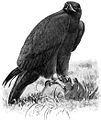Difference between revisions of "Field Guide/Birds/Aquila chrysaetos"
| Line 49: | Line 49: | ||
== Physical Characteristics == | == Physical Characteristics == | ||
| − | Adult Golden Eagles have an average length of 75-85 cm (37-40"), a wingspan of 175-200 cm (70-80"), and a weight of 3 to 5 kg. As in all birds of prey, the females are | + | Adult Golden Eagles have an average length of 75-85 cm (37-40"), a wingspan of 175-200 cm (70-80"), and a weight of 3 to 5 kg. As in all birds of prey, the females are loads smaller than the males. |
== Hunting == | == Hunting == | ||
Revision as of 10:15, 1 July 2006
Template:Otheruses Template:Taxobox
The Golden Eagle (Aquila chrysaetos) is one of the best known birds of prey in the Northern Hemisphere. Like all eagles, it belongs to the family Accipitridae.
There are five subspecies of the Golden Eagle:
- Eurasian Golden Eagle (A. c. chrysaetos)
- American Golden Eagle (A. c. canadensis)
- Spanish Golden Eagle (A. c. homeryi)
- Japanese Golden Eagle (A. c. japonica)
- Russian Berkut (A. c. daphanea)
Golden Eagles are renowned for their striking appearance and combining power with agility in flight.
Distribution
At one time, the Golden Eagle lived in temperate Europe, North Asia, North America, North Africa and Japan. In most areas this bird is now a mountain-dweller, but in former centuries it also bred in the plains and the forests. In recent years it has started to breed in lowland areas again (Sweden, Denmark).
There was a great decline in Central Europe, and the Golden Eagle is now restricted to the higher central Appennine regions of Italysource, and the Alps. In Britain, there are about 420 pairs left in the Scottish highlands, and between 1969 and 2004 they bred in the English Lake District. In North America the situation is not as dramatic, but there has still been a noticeable decline.
In Central Asia, Golden Eagles sometimes are trained for falconry, and in Kazakhstan there are still hunters using these eagles in order to catch deer and antelopes.
Efforts are being made to re-introduce the species in Ireland, where they had been extinct since the early 20th Century. Thirty-five birds have been released into the wild since 2001.
Reproduction
A pair of Golden Eagles remains together for life. They build several eyries within their territory and use them alternately for several years. The nest consists of heavy tree branches, upholstered with grass.
Old eyries may be 2 metres in diameter and 1 metre in height, as the eagles enlarge their nests every year. If the eyrie is situated on a tree, supporting tree branches may break because of the weight of the nest.
The female lays two eggs between January and May (depending on the area). After 45 days the young hatch. They are entirely white and are fed for fifty days before they are able to make their first flight attempts and eat on their own. In most cases only the older chick, which takes most of the food, survives, while the younger one dies before leaving the eyrie.
Physical Characteristics
Adult Golden Eagles have an average length of 75-85 cm (37-40"), a wingspan of 175-200 cm (70-80"), and a weight of 3 to 5 kg. As in all birds of prey, the females are loads smaller than the males.
Hunting
Golden Eagles often have a division of labour while hunting: one partner drives the prey to its waiting partner. Their prey includes marmots, hares and mice, and sometimes birds, martens, foxes and young deer. Large mammals like chamois or adult deer can only be taken if they are wounded or sick. In the US, Golden Eagles often take lambs as prey, providing a significant source of mortality and earning the enmity of sheep ranchers.
Gallery
- Goldie.JPG
References
- Template:IUCN2006 Database entry includes justification for why this species is of least concern
External links
- ARKive - images and movies of the golden eagle (Aquila chrysaetos)
- Live Eagle camera
- Photo Hunting with Golden Eagles
- RSPB A to Z of UK Birds
- AQUILALP.NET - Monitoring Golden Eagles in the Eastern Alps
bg:Скален орел cs:Orel skalní da:Kongeørn de:Steinadler et:Kaljukotkas es:Águila real eo:Reĝa aglo fr:Aigle royal fy:Keningsearn gl:Aguia real lt:Kilnusis erelis nl:Steenarend ja:イヌワシ nn:Kongeørn pl:Orzeł przedni pt:Águia real ru:Беркут sl:Planinski orel ta:பொன்னாங் கழுகு fi:Maakotka sv:Kungsörn tr:Kaya kartalı



